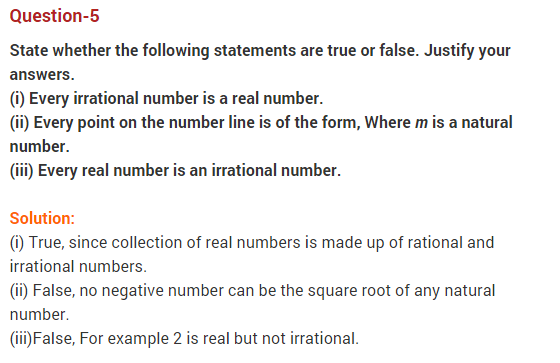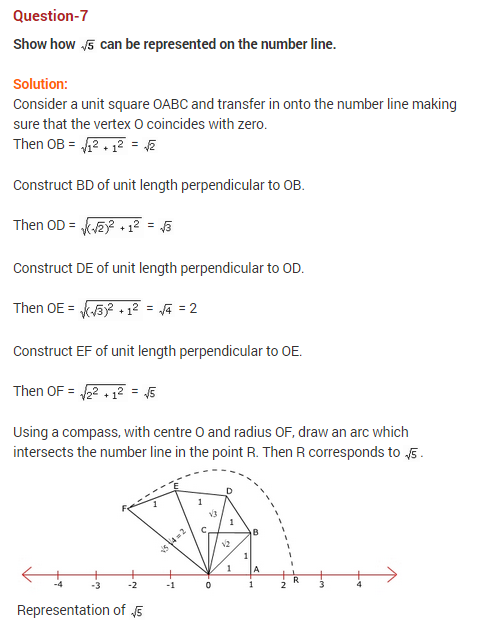Class 9 Maths – Number System Ex 1.2

More Resources for CBSE Class 9


Access Answers to Maths NCERT Class 9 Chapter 1 – Number Systems Exercise 1.2
1. State whether the following statements are true or false. Justify your answer.
(i) Every irrational number is a real number.
Solution:
True
Irrational numbers – A number is said to be irrational if it cannot be written in the p/q, where p and q are integers and q ≠ 0.
i.e., Irrational numbers = π, e, √3, 5+√2, 6.23146…. , 0.101001001000….
Real numbers – The collection of both rational and irrational numbers is known as real numbers.
i.e., Real numbers = √2, √5, 0.102…
Every irrational number is a real number; however, every real number is not an irrational number.
(ii) Every point on the number line is of the form √m, where m is a natural number.
Solution:
False
The statement is false since, as per the rule, a negative number cannot be expressed as square roots.
For example, √9 = 3 is a natural number.
But √2 = 1.414 is not a natural number.
Similarly, we know that there are negative numbers on the number line, but when we take the root of a negative number, it becomes a complex number and not a natural number.
For example, √-7 = 7i, where i = √-1
The statement that every point on the number line is of the form √m, where m is a natural number, is false.
(iii) Every real number is an irrational number.
Solution:
False
The statement is false, the real numbers include both irrational and rational numbers. Therefore, every real number cannot be an irrational number.
Real numbers – The collection of both rational and irrational numbers is known as real numbers.
i.e., Real numbers = √2, √5, 0.102…
Irrational numbers – A number is said to be irrational if it cannot be written in the p/q, where p and q are integers and q ≠ 0.
i.e., Irrational numbers = π, e, √3, 5+√2, 6.23146…. , 0.101001001000….
Every irrational number is a real number; however, every real number is not irrational.
2. Are the square roots of all positive integers irrational? If not, give an example of the square root of a number that is a rational number.
Solution:
No, the square roots of all positive integers are not irrational.
For example,
√4 = 2 is rational.
√9 = 3 is rational.
Hence, the square roots of positive integers 4 and 9 (2 and 3, respectively) are not irrational.
3. Show how √5 can be represented on the number line.
Solution:
Step 1: Let line AB be of 2 units on a number line.
Step 2: At B, draw a perpendicular line BC of length 1 unit.
Step3: Join CA
Step 4: Now, ABC is a right-angled triangle. Applying the Pythagoras theorem,
AB2+BC2 = CA2
22+12 = CA2 CA2 = 5
⇒ CA = √5 . Thus, CA is a line of length √5 unit.
Step 4: Taking CA as a radius and A as a centre, draw an arc touching the number line. The point at which the number line gets intersected by an arc is at √5 distance from 0 because it is the radius of the circle whose centre was A.
Thus, √5 is represented on the number line, as shown in the figure.

4. Classroom activity (Constructing the ‘square root spiral’): Take a large sheet of paper and construct the ‘square root spiral’ in the following fashion. Start with a point O and draw a line segment OP1 of unit length. Draw a line segment P1P2 perpendicular to OP1 of unit length (see Fig. 1.9). Now draw a line segment P2P3 perpendicular to OP2. Then draw a line segment P3P4 perpendicular to OP3. Continuing in Fig. 1.9:

Constructing this manner, you can get the line segment Pn-1Pn by square root spiral drawing a line segment of unit length perpendicular to OPn-1. In this manner, you can create the points P2, P3,…., Pn,… ., and join them to create a beautiful spiral depicting √2, √3, √4, …
Solution:

Step 1: Mark a point O on the paper. Here, O will be the centre of the square root spiral.
Step 2: From O, draw a straight line, OA, of 1 cm horizontally.
Step3: From A, draw a perpendicular line, AB, of 1 cm.
Step 4: Join OB. Here, OB will be of √2.
Step 5: Now, from B, draw a perpendicular line of 1 cm and mark the end point C.
Step 6: Join OC. Here, OC will be of √3.
Step 7: Repeat the steps to draw √4, √5, √6….
Download Mennta App and get access to free video lectures and hand crafted notes.